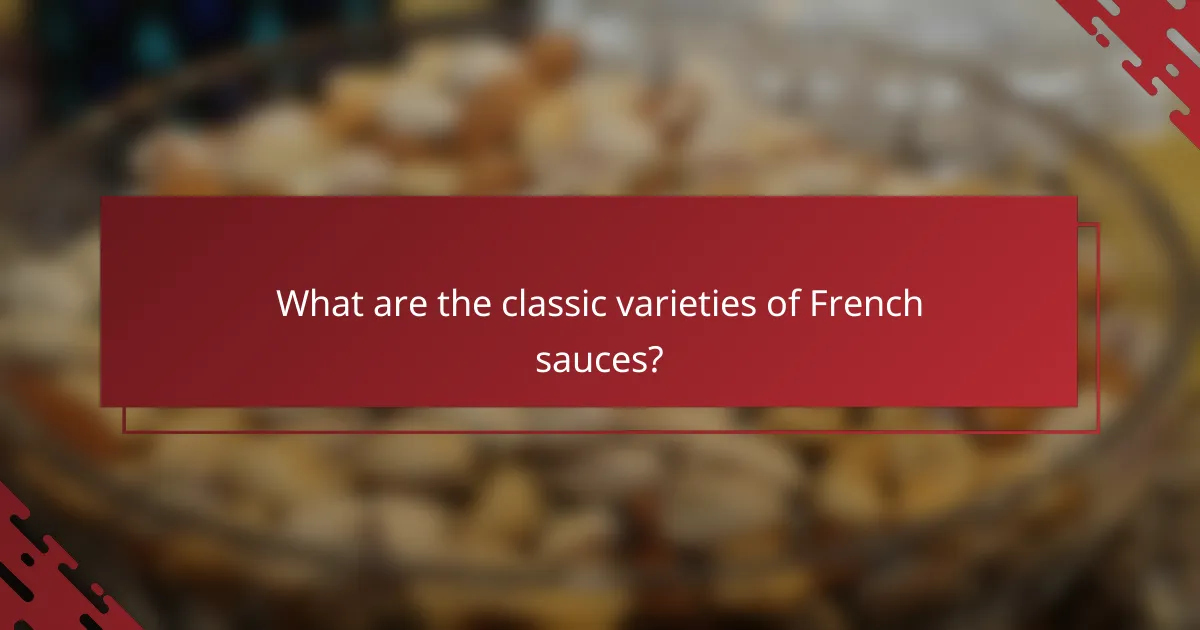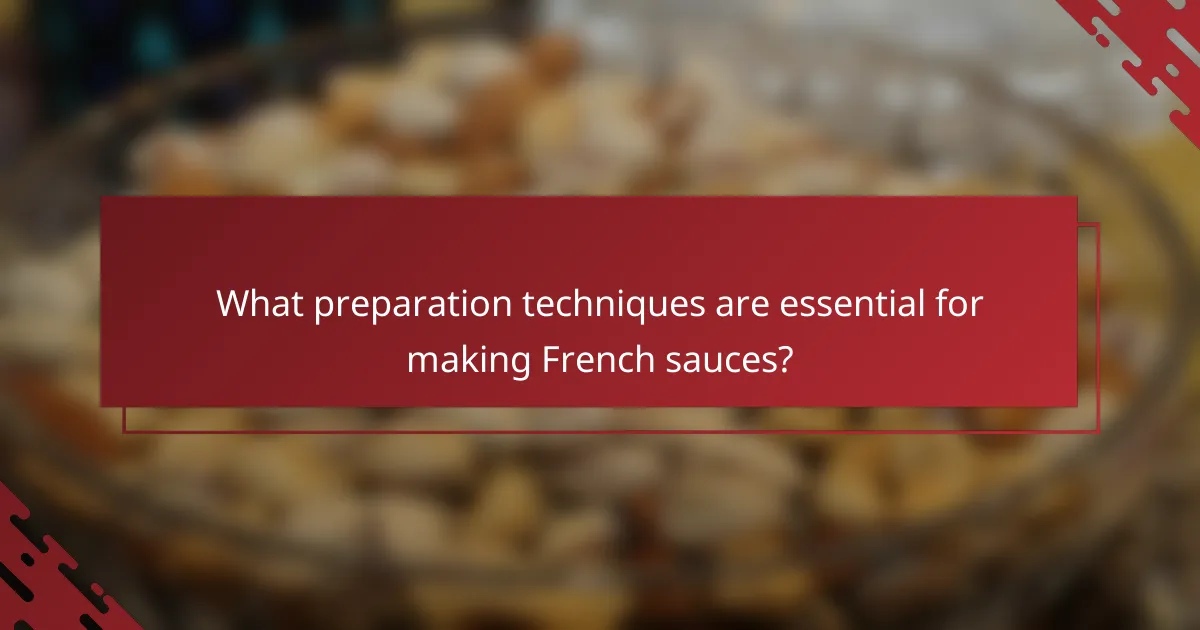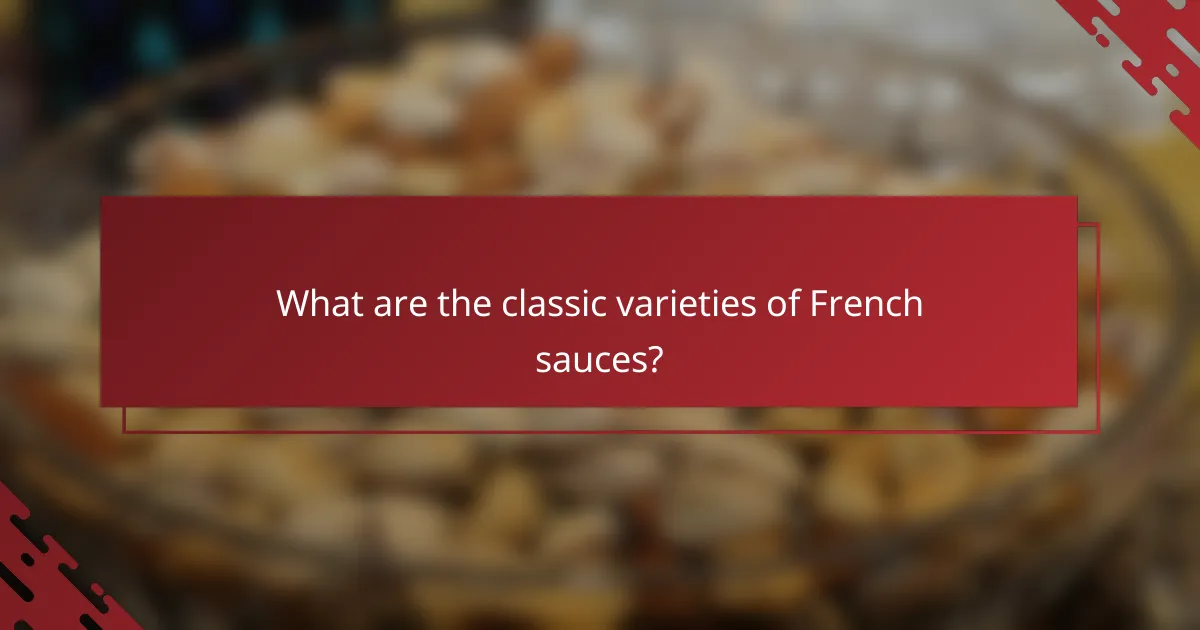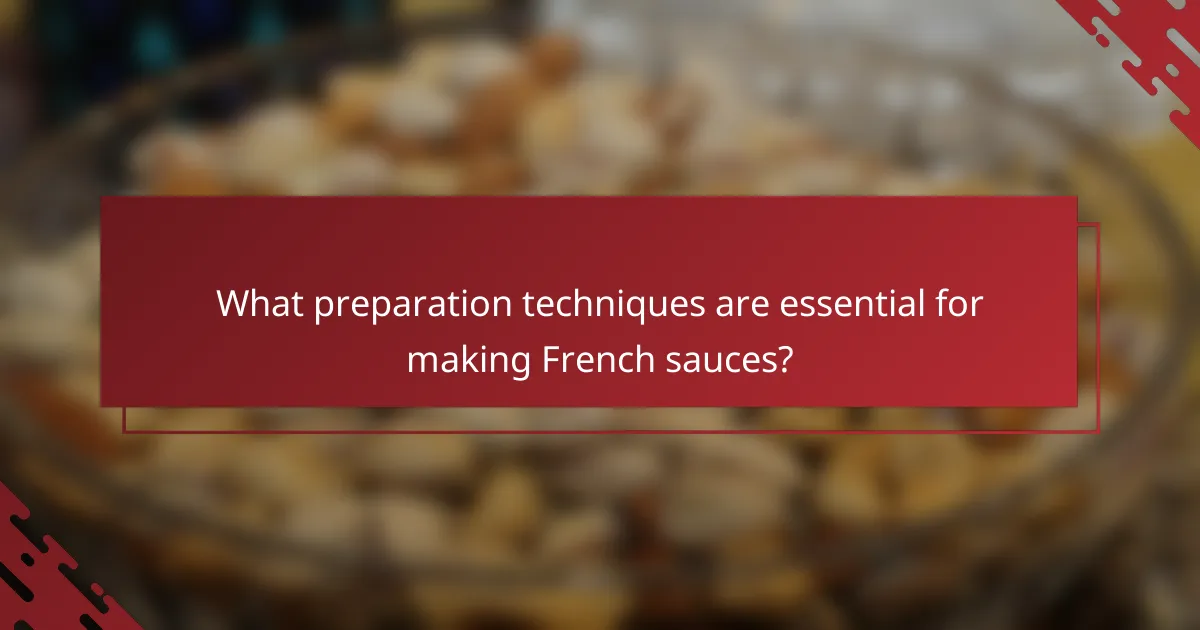French sauces are foundational components of classical French cuisine, with classic varieties including Béchamel, Velouté, Espagnole, Hollandaise, and Tomato sauce. Key preparation techniques for these sauces involve creating a roux, reducing liquids, and emulsifying, each contributing to the sauce’s texture and flavor. The article also explores how to effectively pair these sauces with various dishes, emphasizing the importance of matching flavor profiles to enhance the overall dining experience. Through understanding these essential sauces and techniques, readers can elevate their culinary skills and appreciate the art of French cooking.

What are the classic varieties of French sauces?
The classic varieties of French sauces include Béchamel, Velouté, Espagnole, Hollandaise, and Tomato sauce. Béchamel is a white sauce made from milk and a roux. Velouté is a light stock-based sauce thickened with a roux. Espagnole, or brown sauce, is made from brown stock, mirepoix, and a brown roux. Hollandaise is an emulsion of egg yolks, butter, and lemon juice. Tomato sauce is made from tomatoes, vegetables, and seasonings. These sauces form the foundation of French cuisine and are essential in classical cooking techniques.
How are French sauces categorized?
French sauces are categorized primarily into five mother sauces. These are béchamel, velouté, espagnole, hollandaise, and tomato sauce. Each mother sauce serves as a base for various derivative sauces. Béchamel is a white sauce made from milk and a roux. Velouté is a light stock-based sauce thickened with a roux. Espagnole, also known as brown sauce, combines brown stock with a roux and tomatoes. Hollandaise is an emulsified sauce made from egg yolks, butter, and lemon juice. Tomato sauce is made from tomatoes and can be seasoned in various ways. This categorization is foundational in classical French cuisine, as taught in culinary schools worldwide.
What are the key characteristics of mother sauces?
Mother sauces are the five foundational sauces in French cuisine. They include béchamel, velouté, espagnole, tomato, and hollandaise. Each sauce serves as a base for various derivative sauces. Béchamel is a white sauce made from milk and a roux. Velouté is a light stock-based sauce thickened with a roux. Espagnole is a rich brown sauce made from brown stock and tomatoes. Tomato sauce is made primarily from tomatoes and is often seasoned. Hollandaise is an emulsified sauce made from egg yolks, butter, and lemon juice. These sauces are essential in classical cooking techniques. They form the basis for countless variations and adaptations in culinary practices.
Which derivative sauces are commonly used in French cuisine?
Derivative sauces commonly used in French cuisine include béchamel, hollandaise, and velouté. Béchamel is a white sauce made from milk, butter, and flour. It serves as a base for many other sauces. Hollandaise is an emulsified sauce made from egg yolks, butter, and lemon juice. It is known for its rich flavor and is often used in dishes like Eggs Benedict. Velouté is a light stock-based sauce thickened with a roux. These sauces are foundational in classical French cooking and are used to create a variety of other sauces.
What are the most popular classic French sauces?
The most popular classic French sauces are Béchamel, Velouté, Espagnole, Hollandaise, and Tomato sauce. Béchamel is a white sauce made from milk and flour. It serves as a base for many other sauces. Velouté is a light stock-based sauce thickened with a roux. It is often used in soups and stews. Espagnole, or brown sauce, is made from a dark roux, beef stock, and tomatoes. It is a foundational sauce in French cuisine. Hollandaise is an emulsion of egg yolk, butter, and lemon juice. It is commonly served with vegetables and eggs. Tomato sauce, made from tomatoes and various seasonings, is versatile and widely used. These sauces are fundamental in French cooking and form the basis for many derivative sauces.
What is Béchamel sauce and how is it used?
Béchamel sauce is a classic white sauce made from a roux of butter and flour, combined with milk. It serves as a base for many dishes, including lasagna, macaroni and cheese, and creamy soups. Béchamel is one of the five mother sauces in French cuisine. Its smooth texture and mild flavor allow it to complement various ingredients. The sauce can be enhanced with cheese, herbs, or spices for additional flavor. Béchamel is often used in gratins and as a binding agent in casseroles. Its versatility makes it a staple in both professional and home kitchens.
What is Velouté sauce and what dishes does it enhance?
Velouté sauce is a classic French sauce made by thickening white stock with a roux. It serves as a base for many other sauces, including Allemande and suprême. Velouté enhances various dishes, particularly poultry, seafood, and vegetables. It is commonly used in dishes like chicken fricassée, fish stew, and vegetable gratin. The sauce adds richness and depth of flavor, making it a versatile component in French cuisine.
How is Espagnole sauce prepared and what are its uses?
Espagnole sauce is prepared by creating a brown roux, which is cooked until it reaches a deep color. Next, mirepoix consisting of onions, carrots, and celery is added and sautéed. Then, tomato purée is incorporated and cooked down to enhance flavor. After that, beef or veal stock is gradually whisked in to achieve a smooth consistency. The sauce is simmered for several hours to develop its rich taste. Finally, the sauce is strained to remove solids, resulting in a velvety texture.
Espagnole sauce is a foundational sauce in classical French cuisine. It serves as a base for various derivative sauces, such as demi-glace and Bordelaise. Additionally, it is used to enhance the flavor of meats, stews, and braised dishes. Its rich and complex flavor profile complements hearty dishes, making it a versatile component in gourmet cooking.
What makes Hollandaise sauce unique in French cooking?
Hollandaise sauce is unique in French cooking due to its emulsification process and rich flavor profile. This sauce is made primarily from egg yolks, butter, and lemon juice or vinegar. The technique requires careful temperature control to achieve a smooth, creamy texture. Hollandaise is one of the five mother sauces in French cuisine, highlighting its foundational importance. It is often used in classic dishes such as Eggs Benedict. The balance of acidity from lemon juice enhances its flavor, making it versatile for various dishes. Its distinct buttery richness sets it apart from other sauces. The historical significance of Hollandaise dates back to the 19th century, further emphasizing its role in French culinary tradition.
What is Tomato sauce’s role in French gastronomy?
Tomato sauce serves as a foundational component in French gastronomy. It is used in a variety of classic dishes. The sauce enhances flavors and adds depth to meals. Traditional French recipes often incorporate tomato sauce in stews and braises. It is a key ingredient in dishes like ratatouille and certain pasta recipes. Additionally, tomato sauce is essential in French cuisine for its versatility. It can be paired with meats, vegetables, and grains. The use of tomato sauce dates back to the 19th century in French cooking.

What preparation techniques are essential for making French sauces?
Essential preparation techniques for making French sauces include creating a roux, reducing liquids, and emulsifying. A roux is made by cooking equal parts flour and fat, typically butter, to thicken sauces. Reducing involves simmering a liquid to concentrate flavors and achieve desired consistency. Emulsifying combines fat and water-based ingredients, ensuring a smooth sauce, often seen in vinaigrettes or hollandaise. Mastery of these techniques is fundamental for classic French sauces like béchamel, velouté, and hollandaise. Each technique contributes to the sauce’s texture, flavor depth, and overall quality.
How do you properly prepare a mother sauce?
To properly prepare a mother sauce, start by selecting the type of mother sauce you wish to make, such as béchamel, velouté, espagnole, tomato, or hollandaise. Each sauce has specific ingredients and techniques. For béchamel, melt butter, add flour to create a roux, then gradually whisk in milk until smooth. For velouté, create a roux and slowly add stock while whisking. For espagnole, brown mirepoix, add flour for a roux, and incorporate brown stock and tomato paste. For tomato sauce, cook tomatoes with aromatics and seasonings. For hollandaise, emulsify egg yolks with melted butter and lemon juice over gentle heat. Each preparation method requires careful temperature control and stirring to achieve the desired consistency. Mastering these techniques is essential for creating rich and flavorful sauces that serve as the foundation for many dishes.
What ingredients are necessary for making Béchamel sauce?
Béchamel sauce requires three main ingredients: butter, flour, and milk. Butter is used to create a roux, which is a mixture of equal parts fat and flour. The flour is cooked with the butter to thicken the sauce. Milk is then gradually added to the roux while whisking continuously. This process creates a smooth, creamy sauce. The traditional ratio is often two tablespoons of butter and flour for each cup of milk. This foundational recipe is used in many classic French dishes.
What techniques are involved in creating a perfect Velouté?
To create a perfect Velouté, several key techniques are involved. First, a roux is prepared by cooking equal parts flour and fat, typically butter, until it reaches a pale color. This roux serves as the thickening agent for the sauce. Next, a flavorful stock, such as chicken, fish, or vegetable, is heated separately. The hot stock is then gradually whisked into the roux to prevent lumps from forming. Continuous stirring is essential to achieve a smooth consistency. The mixture is brought to a simmer, allowing it to thicken properly. Finally, the Velouté is seasoned with salt and white pepper to enhance its flavor. This technique is foundational in French cuisine, as it serves as a base for many other sauces.
What are the common mistakes to avoid when making French sauces?
Common mistakes to avoid when making French sauces include neglecting proper temperature control. Cooking sauces at too high a temperature can lead to burning or separation. Another mistake is not using enough time for reduction, which can result in a sauce lacking depth of flavor. Additionally, failing to season adequately throughout the cooking process can lead to bland sauces. Not incorporating ingredients in the correct order can also affect the texture and taste. Lastly, using low-quality ingredients can compromise the final product. High-quality butter, stock, and fresh herbs are essential for authentic flavor.
How can you prevent sauce separation in Hollandaise?
To prevent sauce separation in Hollandaise, maintain a consistent temperature during preparation. Whisk the egg yolks over low heat to create a stable emulsion. Gradually add melted butter while continuously whisking to integrate the fats smoothly. Using clarified butter can help as it has less moisture. If the sauce starts to separate, whisk in a few drops of warm water to re-emulsify. Additionally, ensure all ingredients are at room temperature before mixing. These techniques help maintain the sauce’s stability and prevent separation.
What steps ensure a smooth texture in Tomato sauce?
To ensure a smooth texture in tomato sauce, start with high-quality tomatoes. Fresh or canned whole tomatoes work best. Next, peel the tomatoes to remove any tough skin. After peeling, chop the tomatoes into smaller pieces. Cook the tomatoes over low heat to break them down. Use a blender or food processor to puree the cooked tomatoes for a uniform consistency. Strain the sauce through a fine mesh sieve to eliminate seeds and pulp. Finally, simmer the sauce to thicken it while stirring continuously. Each of these steps contributes to achieving a silky, smooth texture in the final product.

How can you pair French sauces with dishes?
Pair French sauces with dishes by considering the sauce’s flavor profile and the dish’s main ingredients. For example, a rich béchamel sauce complements pasta and vegetables. A tangy hollandaise pairs well with eggs and seafood. For meats, a robust demi-glace enhances flavors in beef and game dishes. Light vinaigrettes work beautifully with salads and grilled vegetables. Each sauce should enhance the dish without overpowering it. Classic pairings often rely on traditional French culinary principles. These guidelines ensure balanced and harmonious flavors in any meal.
What are the best food pairings for classic French sauces?
Classic French sauces pair well with a variety of foods. For example, béchamel complements pasta dishes, lasagna, and vegetables. Velouté sauce is ideal for poultry, fish, and seafood. Espagnole sauce enhances red meats, such as beef and lamb. Hollandaise is traditionally served with eggs, asparagus, and fish. Tomato sauce pairs excellently with pasta, meats, and pizzas. Each sauce enhances the flavor profile of the food it accompanies, creating a harmonious dish.
Which dishes complement Béchamel sauce effectively?
Lasagna, macaroni and cheese, and croque monsieur complement Béchamel sauce effectively. Lasagna layers often include Béchamel for creaminess and richness. Macaroni and cheese uses Béchamel as a base for a creamy cheese sauce. Croque monsieur features Béchamel to enhance the flavor of the ham and cheese sandwich. These dishes highlight the versatility of Béchamel in adding texture and depth.
How can Velouté sauce enhance poultry and seafood dishes?
Velouté sauce enhances poultry and seafood dishes by adding depth of flavor and richness. This sauce is a foundational element in classical French cuisine. It is made from a light stock, typically chicken or fish, thickened with a roux. The creamy texture of Velouté complements the delicate flavors of poultry and seafood. It provides a subtle umami taste that elevates the overall dish. Velouté can be further enriched with ingredients like herbs, mushrooms, or cream, enhancing its versatility. This adaptability allows it to pair well with various cooking methods, from sautéing to braising. The use of Velouté in culinary applications is well-documented in classic French cookbooks.
What tips can improve sauce and dish pairings?
To improve sauce and dish pairings, consider the flavor profiles of both elements. Match the sauce’s intensity with the dish’s richness. For example, a rich béchamel complements creamy pasta well. Use acidity to balance heavier dishes; a tangy sauce can lighten a fatty meat. Experiment with herbs and spices in sauces to enhance the dish’s existing flavors. For instance, a basil pesto pairs beautifully with grilled chicken. Additionally, consider the texture; a smooth sauce may work best with tender proteins. Lastly, regional pairings can guide choices; classic French sauces often match traditional French dishes effectively.
How do flavor profiles influence sauce pairing decisions?
Flavor profiles significantly influence sauce pairing decisions by determining compatibility with food. Different flavor profiles include sweet, sour, salty, bitter, and umami. Each profile can enhance or contrast with the dish’s inherent flavors. For example, a rich, fatty dish pairs well with acidic sauces to cut through the richness. Conversely, a spicy dish may benefit from a cooling, creamy sauce. Understanding these interactions helps chefs create balanced and harmonious meals. Research shows that pairing sauces with complementary flavors enhances the overall dining experience.
What are the best practices for serving sauces with meals?
Serve sauces in a way that complements the meal. Use appropriate portion sizes to avoid overwhelming the dish. Present sauces in separate containers to allow diners to choose their desired amount. Pair sauces with foods that enhance their flavors. For example, rich sauces go well with hearty meats. Light sauces suit delicate proteins like fish. Temperature matters; serve sauces warm with hot dishes and cold sauces with chilled meals. Consider the color and texture of sauces for visual appeal. Lastly, educate diners on the sauce’s ingredients and suggested pairings for a better dining experience.
French sauces are fundamental components of classical cuisine, with five classic varieties known as mother sauces: Béchamel, Velouté, Espagnole, Hollandaise, and Tomato sauce. Each sauce has unique preparation techniques and serves as a base for various derivative sauces, enhancing a wide range of dishes. This article outlines the characteristics of each mother sauce, essential preparation methods, common mistakes to avoid, and effective pairing suggestions to elevate culinary experiences. Detailed insights into specific sauces, such as their ingredients and uses, further illustrate their significance in French gastronomy.

What are the classic varieties of French sauces?
The classic varieties of French sauces include Béchamel, Velouté, Espagnole, Hollandaise, and Tomato sauce. Béchamel is a white sauce made from milk and a roux. Velouté is a light stock-based sauce thickened with a roux. Espagnole, or brown sauce, is made from brown stock, mirepoix, and a brown roux. Hollandaise is an emulsion of egg yolks, butter, and lemon juice. Tomato sauce is made from tomatoes, vegetables, and seasonings. These sauces form the foundation of French cuisine and are essential in classical cooking techniques.
How are French sauces categorized?
French sauces are categorized primarily into five mother sauces. These are béchamel, velouté, espagnole, hollandaise, and tomato sauce. Each mother sauce serves as a base for various derivative sauces. Béchamel is a white sauce made from milk and a roux. Velouté is a light stock-based sauce thickened with a roux. Espagnole, also known as brown sauce, combines brown stock with a roux and tomatoes. Hollandaise is an emulsified sauce made from egg yolks, butter, and lemon juice. Tomato sauce is made from tomatoes and can be seasoned in various ways. This categorization is foundational in classical French cuisine, as taught in culinary schools worldwide.
What are the key characteristics of mother sauces?
Mother sauces are the five foundational sauces in French cuisine. They include béchamel, velouté, espagnole, tomato, and hollandaise. Each sauce serves as a base for various derivative sauces. Béchamel is a white sauce made from milk and a roux. Velouté is a light stock-based sauce thickened with a roux. Espagnole is a rich brown sauce made from brown stock and tomatoes. Tomato sauce is made primarily from tomatoes and is often seasoned. Hollandaise is an emulsified sauce made from egg yolks, butter, and lemon juice. These sauces are essential in classical cooking techniques. They form the basis for countless variations and adaptations in culinary practices.
Which derivative sauces are commonly used in French cuisine?
Derivative sauces commonly used in French cuisine include béchamel, hollandaise, and velouté. Béchamel is a white sauce made from milk, butter, and flour. It serves as a base for many other sauces. Hollandaise is an emulsified sauce made from egg yolks, butter, and lemon juice. It is known for its rich flavor and is often used in dishes like Eggs Benedict. Velouté is a light stock-based sauce thickened with a roux. These sauces are foundational in classical French cooking and are used to create a variety of other sauces.
What are the most popular classic French sauces?
The most popular classic French sauces are Béchamel, Velouté, Espagnole, Hollandaise, and Tomato sauce. Béchamel is a white sauce made from milk and flour. It serves as a base for many other sauces. Velouté is a light stock-based sauce thickened with a roux. It is often used in soups and stews. Espagnole, or brown sauce, is made from a dark roux, beef stock, and tomatoes. It is a foundational sauce in French cuisine. Hollandaise is an emulsion of egg yolk, butter, and lemon juice. It is commonly served with vegetables and eggs. Tomato sauce, made from tomatoes and various seasonings, is versatile and widely used. These sauces are fundamental in French cooking and form the basis for many derivative sauces.
What is Béchamel sauce and how is it used?
Béchamel sauce is a classic white sauce made from a roux of butter and flour, combined with milk. It serves as a base for many dishes, including lasagna, macaroni and cheese, and creamy soups. Béchamel is one of the five mother sauces in French cuisine. Its smooth texture and mild flavor allow it to complement various ingredients. The sauce can be enhanced with cheese, herbs, or spices for additional flavor. Béchamel is often used in gratins and as a binding agent in casseroles. Its versatility makes it a staple in both professional and home kitchens.
What is Velouté sauce and what dishes does it enhance?
Velouté sauce is a classic French sauce made by thickening white stock with a roux. It serves as a base for many other sauces, including Allemande and suprême. Velouté enhances various dishes, particularly poultry, seafood, and vegetables. It is commonly used in dishes like chicken fricassée, fish stew, and vegetable gratin. The sauce adds richness and depth of flavor, making it a versatile component in French cuisine.
How is Espagnole sauce prepared and what are its uses?
Espagnole sauce is prepared by creating a brown roux, which is cooked until it reaches a deep color. Next, mirepoix consisting of onions, carrots, and celery is added and sautéed. Then, tomato purée is incorporated and cooked down to enhance flavor. After that, beef or veal stock is gradually whisked in to achieve a smooth consistency. The sauce is simmered for several hours to develop its rich taste. Finally, the sauce is strained to remove solids, resulting in a velvety texture.
Espagnole sauce is a foundational sauce in classical French cuisine. It serves as a base for various derivative sauces, such as demi-glace and Bordelaise. Additionally, it is used to enhance the flavor of meats, stews, and braised dishes. Its rich and complex flavor profile complements hearty dishes, making it a versatile component in gourmet cooking.
What makes Hollandaise sauce unique in French cooking?
Hollandaise sauce is unique in French cooking due to its emulsification process and rich flavor profile. This sauce is made primarily from egg yolks, butter, and lemon juice or vinegar. The technique requires careful temperature control to achieve a smooth, creamy texture. Hollandaise is one of the five mother sauces in French cuisine, highlighting its foundational importance. It is often used in classic dishes such as Eggs Benedict. The balance of acidity from lemon juice enhances its flavor, making it versatile for various dishes. Its distinct buttery richness sets it apart from other sauces. The historical significance of Hollandaise dates back to the 19th century, further emphasizing its role in French culinary tradition.
What is Tomato sauce’s role in French gastronomy?
Tomato sauce serves as a foundational component in French gastronomy. It is used in a variety of classic dishes. The sauce enhances flavors and adds depth to meals. Traditional French recipes often incorporate tomato sauce in stews and braises. It is a key ingredient in dishes like ratatouille and certain pasta recipes. Additionally, tomato sauce is essential in French cuisine for its versatility. It can be paired with meats, vegetables, and grains. The use of tomato sauce dates back to the 19th century in French cooking.

What preparation techniques are essential for making French sauces?
Essential preparation techniques for making French sauces include creating a roux, reducing liquids, and emulsifying. A roux is made by cooking equal parts flour and fat, typically butter, to thicken sauces. Reducing involves simmering a liquid to concentrate flavors and achieve desired consistency. Emulsifying combines fat and water-based ingredients, ensuring a smooth sauce, often seen in vinaigrettes or hollandaise. Mastery of these techniques is fundamental for classic French sauces like béchamel, velouté, and hollandaise. Each technique contributes to the sauce’s texture, flavor depth, and overall quality.
How do you properly prepare a mother sauce?
To properly prepare a mother sauce, start by selecting the type of mother sauce you wish to make, such as béchamel, velouté, espagnole, tomato, or hollandaise. Each sauce has specific ingredients and techniques. For béchamel, melt butter, add flour to create a roux, then gradually whisk in milk until smooth. For velouté, create a roux and slowly add stock while whisking. For espagnole, brown mirepoix, add flour for a roux, and incorporate brown stock and tomato paste. For tomato sauce, cook tomatoes with aromatics and seasonings. For hollandaise, emulsify egg yolks with melted butter and lemon juice over gentle heat. Each preparation method requires careful temperature control and stirring to achieve the desired consistency. Mastering these techniques is essential for creating rich and flavorful sauces that serve as the foundation for many dishes.
What ingredients are necessary for making Béchamel sauce?
Béchamel sauce requires three main ingredients: butter, flour, and milk. Butter is used to create a roux, which is a mixture of equal parts fat and flour. The flour is cooked with the butter to thicken the sauce. Milk is then gradually added to the roux while whisking continuously. This process creates a smooth, creamy sauce. The traditional ratio is often two tablespoons of butter and flour for each cup of milk. This foundational recipe is used in many classic French dishes.
What techniques are involved in creating a perfect Velouté?
To create a perfect Velouté, several key techniques are involved. First, a roux is prepared by cooking equal parts flour and fat, typically butter, until it reaches a pale color. This roux serves as the thickening agent for the sauce. Next, a flavorful stock, such as chicken, fish, or vegetable, is heated separately. The hot stock is then gradually whisked into the roux to prevent lumps from forming. Continuous stirring is essential to achieve a smooth consistency. The mixture is brought to a simmer, allowing it to thicken properly. Finally, the Velouté is seasoned with salt and white pepper to enhance its flavor. This technique is foundational in French cuisine, as it serves as a base for many other sauces.
What are the common mistakes to avoid when making French sauces?
Common mistakes to avoid when making French sauces include neglecting proper temperature control. Cooking sauces at too high a temperature can lead to burning or separation. Another mistake is not using enough time for reduction, which can result in a sauce lacking depth of flavor. Additionally, failing to season adequately throughout the cooking process can lead to bland sauces. Not incorporating ingredients in the correct order can also affect the texture and taste. Lastly, using low-quality ingredients can compromise the final product. High-quality butter, stock, and fresh herbs are essential for authentic flavor.
How can you prevent sauce separation in Hollandaise?
To prevent sauce separation in Hollandaise, maintain a consistent temperature during preparation. Whisk the egg yolks over low heat to create a stable emulsion. Gradually add melted butter while continuously whisking to integrate the fats smoothly. Using clarified butter can help as it has less moisture. If the sauce starts to separate, whisk in a few drops of warm water to re-emulsify. Additionally, ensure all ingredients are at room temperature before mixing. These techniques help maintain the sauce’s stability and prevent separation.
What steps ensure a smooth texture in Tomato sauce?
To ensure a smooth texture in tomato sauce, start with high-quality tomatoes. Fresh or canned whole tomatoes work best. Next, peel the tomatoes to remove any tough skin. After peeling, chop the tomatoes into smaller pieces. Cook the tomatoes over low heat to break them down. Use a blender or food processor to puree the cooked tomatoes for a uniform consistency. Strain the sauce through a fine mesh sieve to eliminate seeds and pulp. Finally, simmer the sauce to thicken it while stirring continuously. Each of these steps contributes to achieving a silky, smooth texture in the final product.

How can you pair French sauces with dishes?
Pair French sauces with dishes by considering the sauce’s flavor profile and the dish’s main ingredients. For example, a rich béchamel sauce complements pasta and vegetables. A tangy hollandaise pairs well with eggs and seafood. For meats, a robust demi-glace enhances flavors in beef and game dishes. Light vinaigrettes work beautifully with salads and grilled vegetables. Each sauce should enhance the dish without overpowering it. Classic pairings often rely on traditional French culinary principles. These guidelines ensure balanced and harmonious flavors in any meal.
What are the best food pairings for classic French sauces?
Classic French sauces pair well with a variety of foods. For example, béchamel complements pasta dishes, lasagna, and vegetables. Velouté sauce is ideal for poultry, fish, and seafood. Espagnole sauce enhances red meats, such as beef and lamb. Hollandaise is traditionally served with eggs, asparagus, and fish. Tomato sauce pairs excellently with pasta, meats, and pizzas. Each sauce enhances the flavor profile of the food it accompanies, creating a harmonious dish.
Which dishes complement Béchamel sauce effectively?
Lasagna, macaroni and cheese, and croque monsieur complement Béchamel sauce effectively. Lasagna layers often include Béchamel for creaminess and richness. Macaroni and cheese uses Béchamel as a base for a creamy cheese sauce. Croque monsieur features Béchamel to enhance the flavor of the ham and cheese sandwich. These dishes highlight the versatility of Béchamel in adding texture and depth.
How can Velouté sauce enhance poultry and seafood dishes?
Velouté sauce enhances poultry and seafood dishes by adding depth of flavor and richness. This sauce is a foundational element in classical French cuisine. It is made from a light stock, typically chicken or fish, thickened with a roux. The creamy texture of Velouté complements the delicate flavors of poultry and seafood. It provides a subtle umami taste that elevates the overall dish. Velouté can be further enriched with ingredients like herbs, mushrooms, or cream, enhancing its versatility. This adaptability allows it to pair well with various cooking methods, from sautéing to braising. The use of Velouté in culinary applications is well-documented in classic French cookbooks.
What tips can improve sauce and dish pairings?
To improve sauce and dish pairings, consider the flavor profiles of both elements. Match the sauce’s intensity with the dish’s richness. For example, a rich béchamel complements creamy pasta well. Use acidity to balance heavier dishes; a tangy sauce can lighten a fatty meat. Experiment with herbs and spices in sauces to enhance the dish’s existing flavors. For instance, a basil pesto pairs beautifully with grilled chicken. Additionally, consider the texture; a smooth sauce may work best with tender proteins. Lastly, regional pairings can guide choices; classic French sauces often match traditional French dishes effectively.
How do flavor profiles influence sauce pairing decisions?
Flavor profiles significantly influence sauce pairing decisions by determining compatibility with food. Different flavor profiles include sweet, sour, salty, bitter, and umami. Each profile can enhance or contrast with the dish’s inherent flavors. For example, a rich, fatty dish pairs well with acidic sauces to cut through the richness. Conversely, a spicy dish may benefit from a cooling, creamy sauce. Understanding these interactions helps chefs create balanced and harmonious meals. Research shows that pairing sauces with complementary flavors enhances the overall dining experience.
What are the best practices for serving sauces with meals?
Serve sauces in a way that complements the meal. Use appropriate portion sizes to avoid overwhelming the dish. Present sauces in separate containers to allow diners to choose their desired amount. Pair sauces with foods that enhance their flavors. For example, rich sauces go well with hearty meats. Light sauces suit delicate proteins like fish. Temperature matters; serve sauces warm with hot dishes and cold sauces with chilled meals. Consider the color and texture of sauces for visual appeal. Lastly, educate diners on the sauce’s ingredients and suggested pairings for a better dining experience.